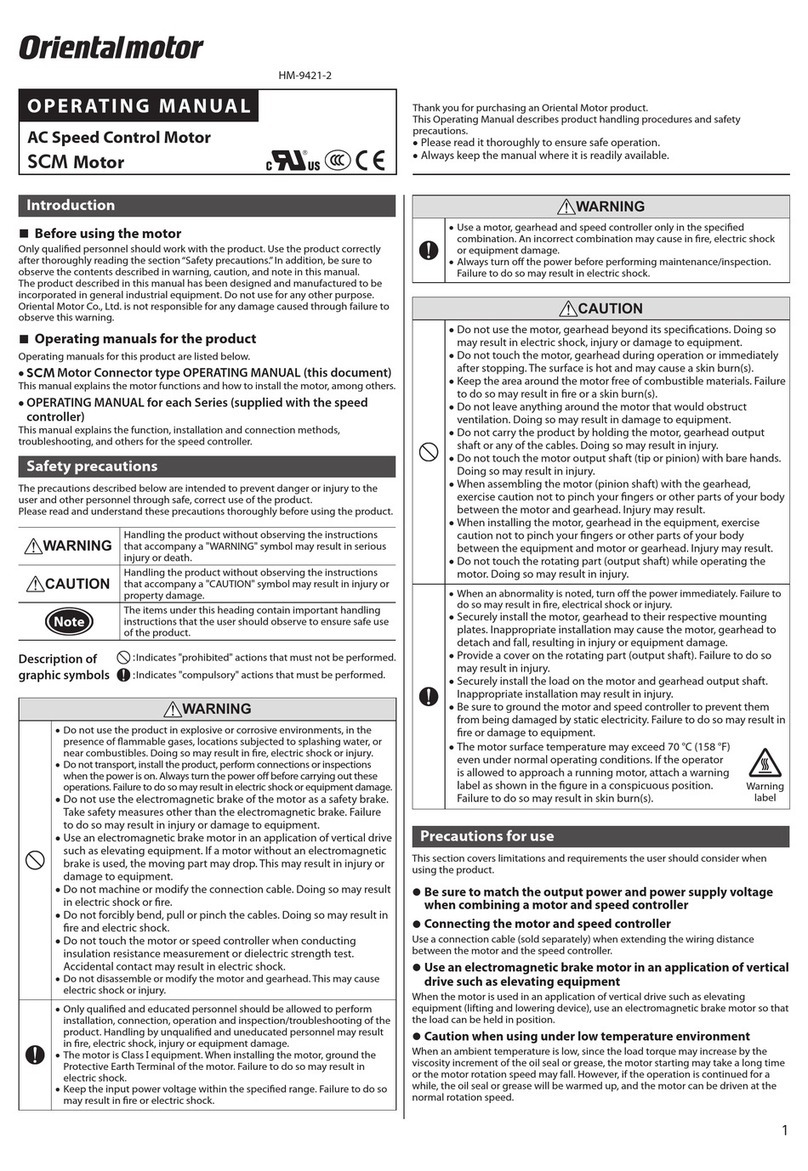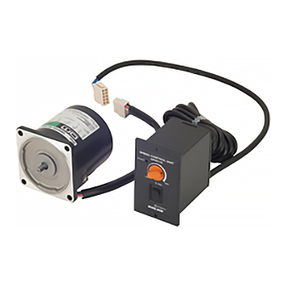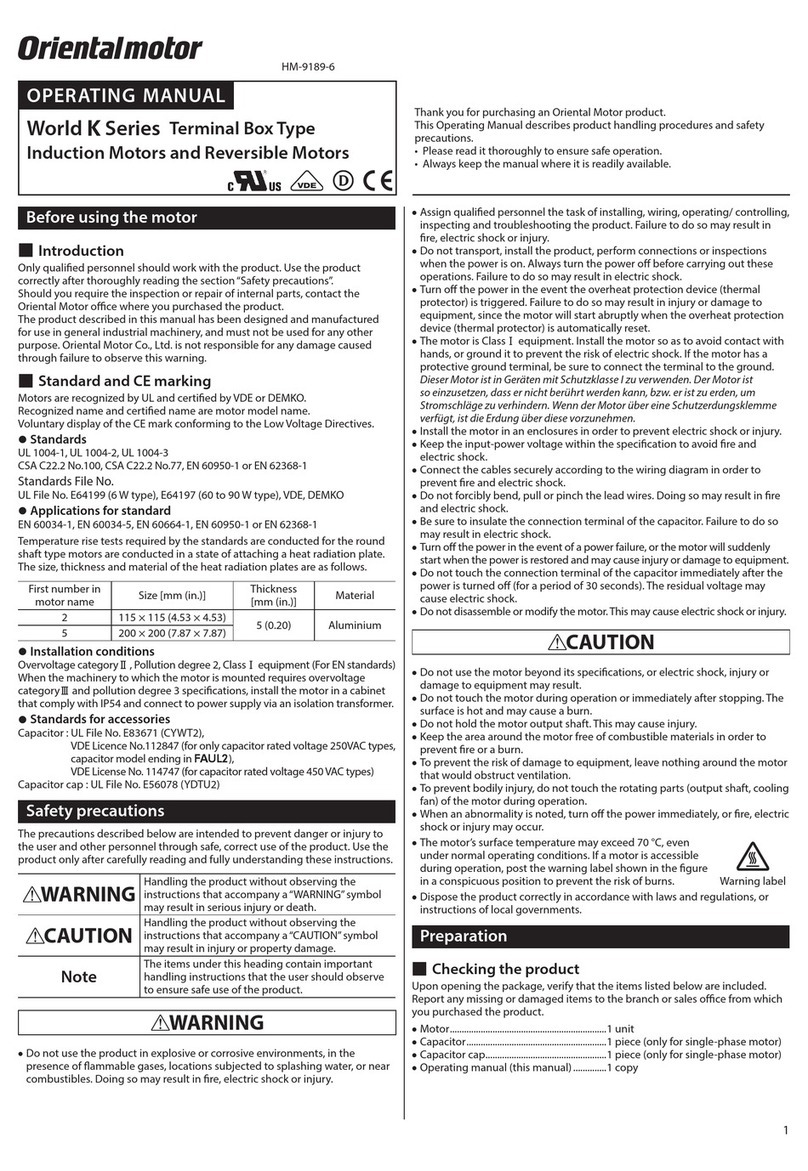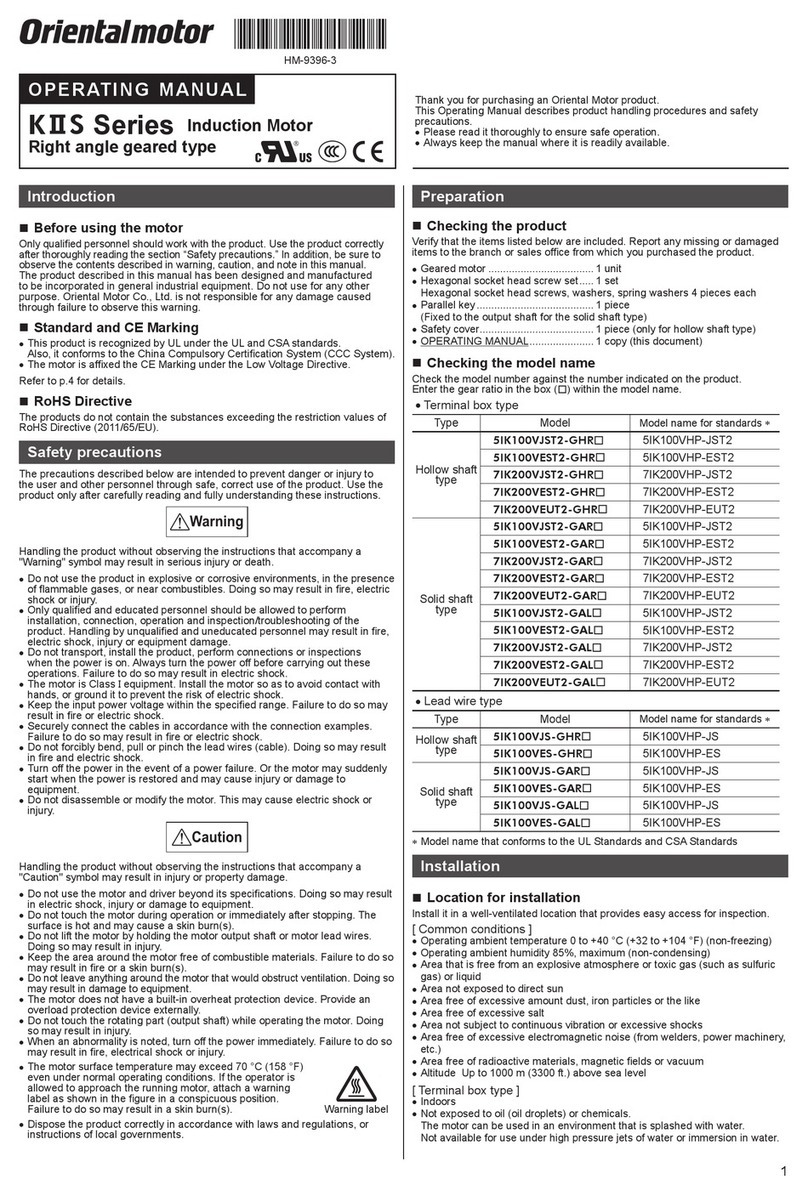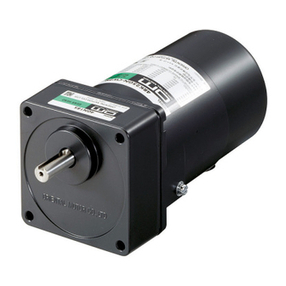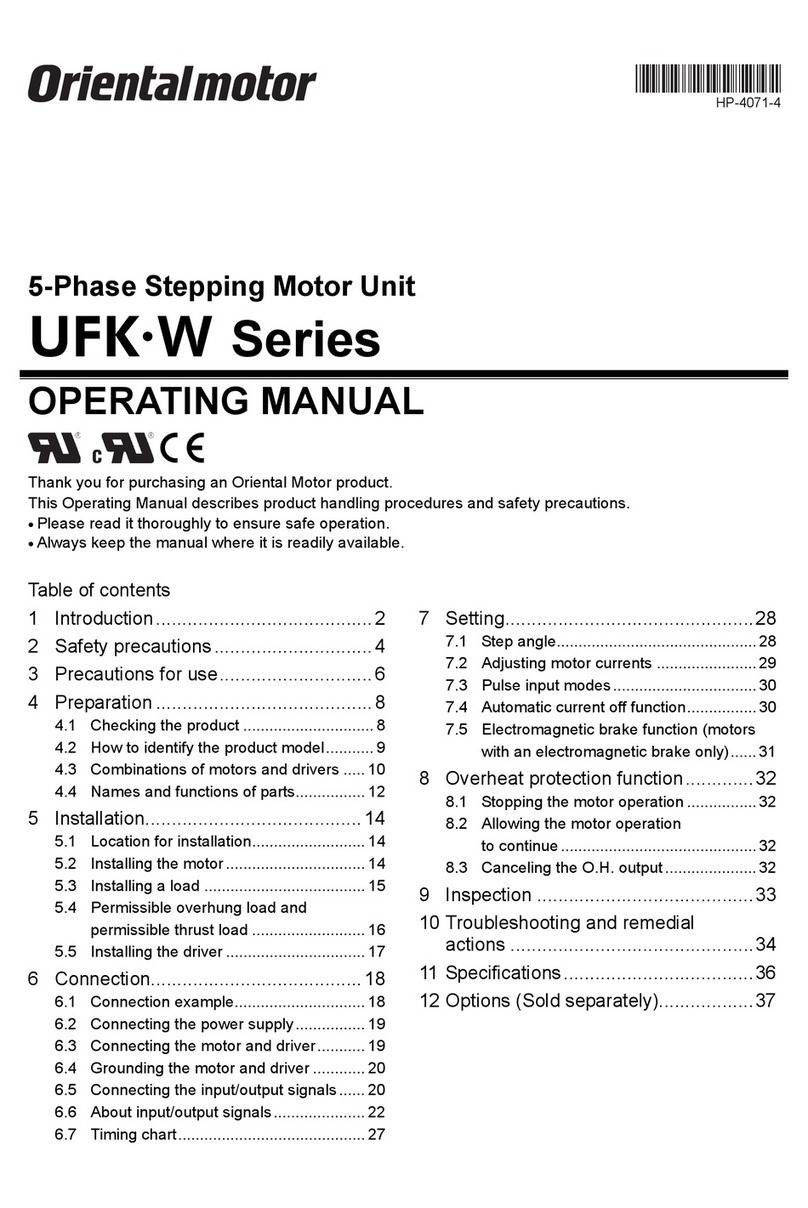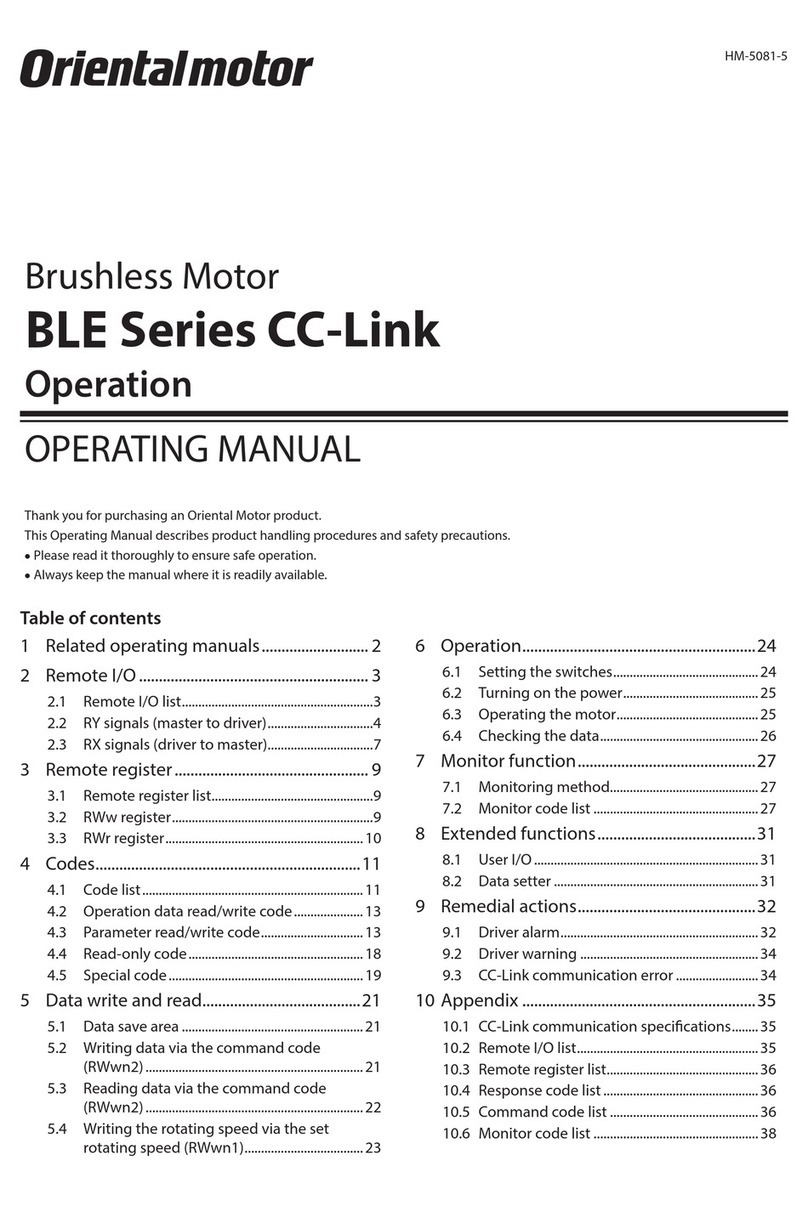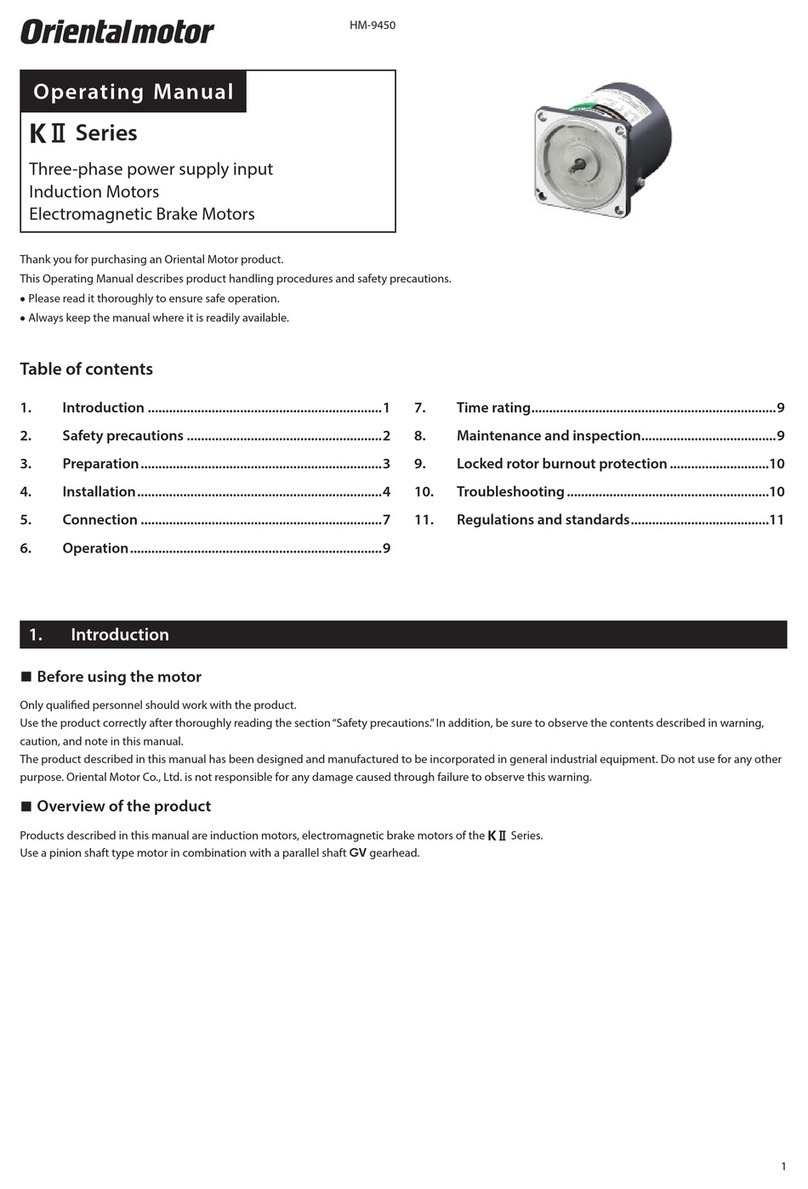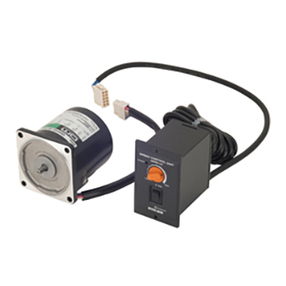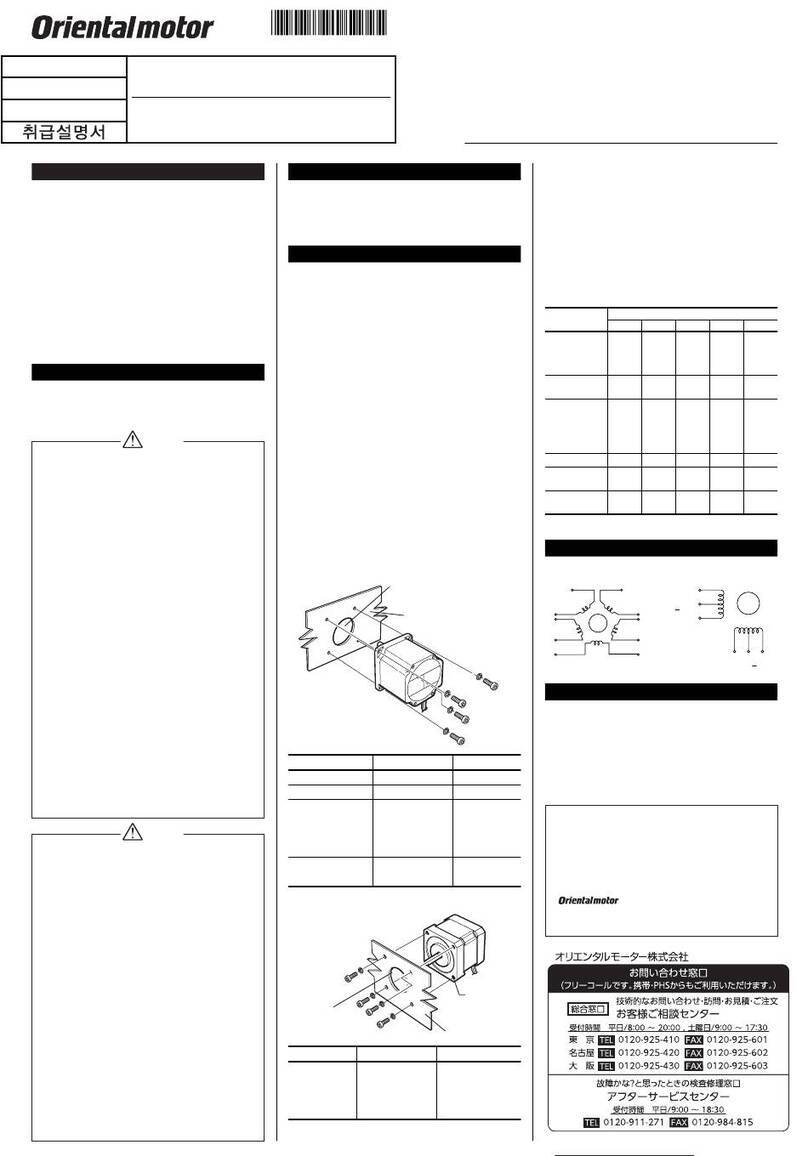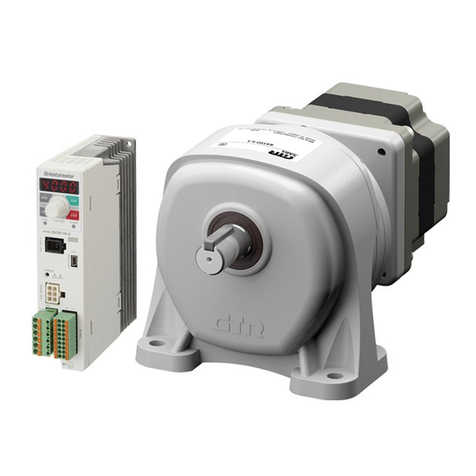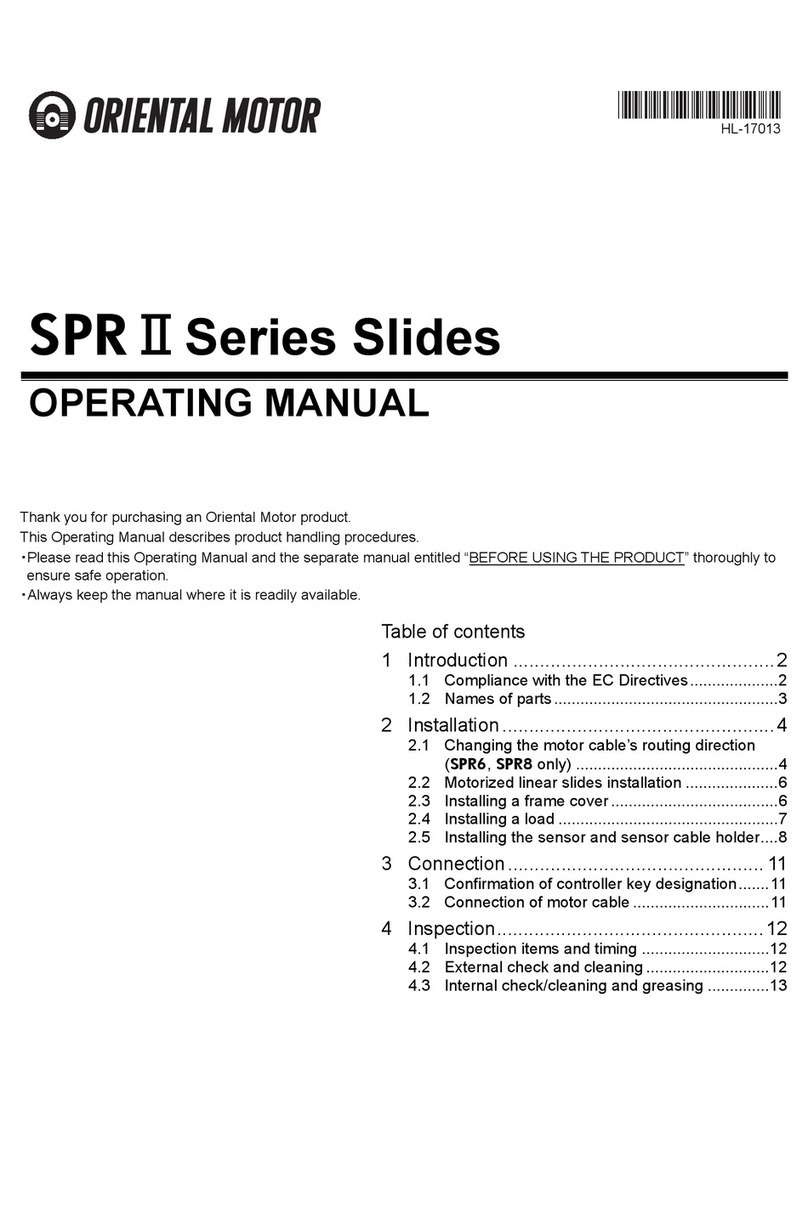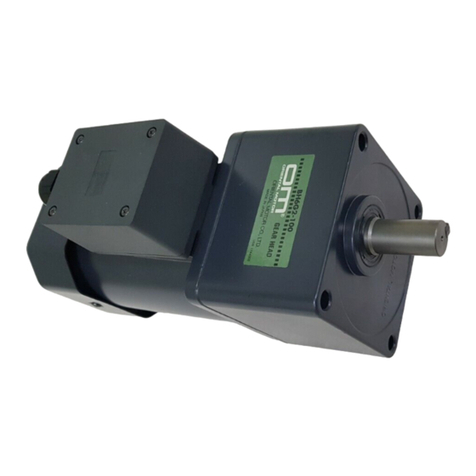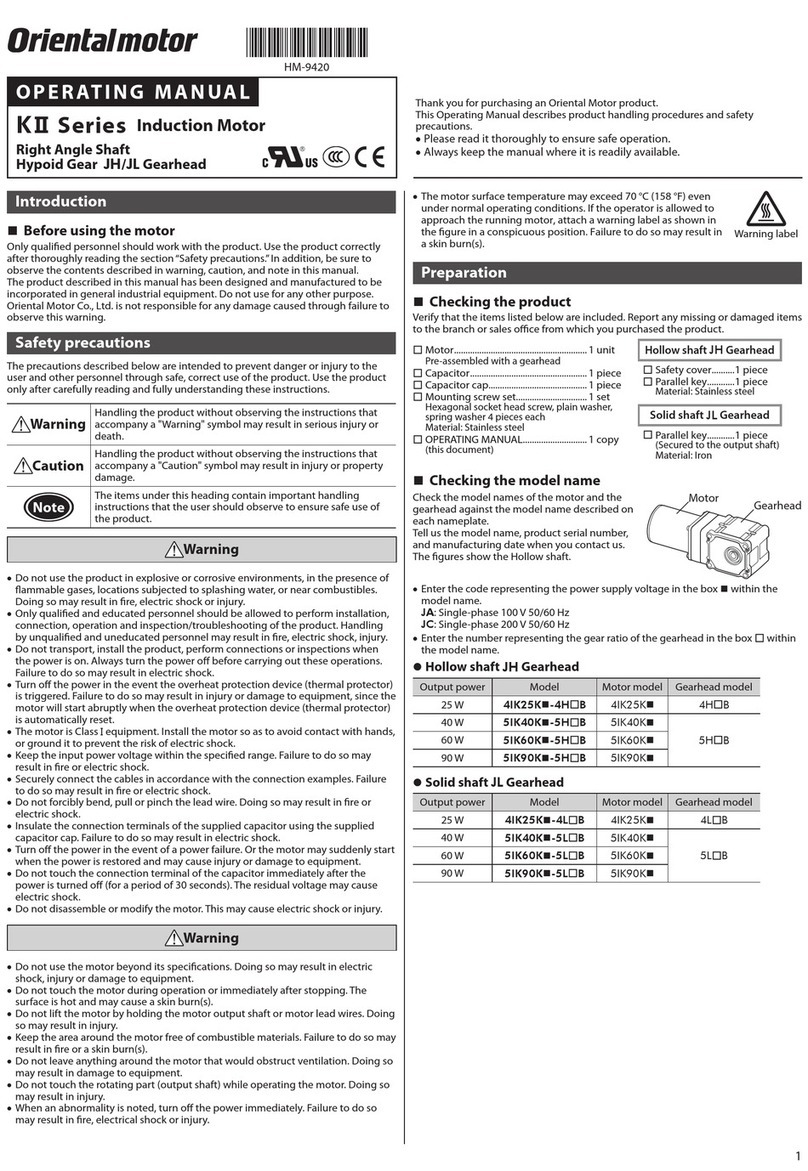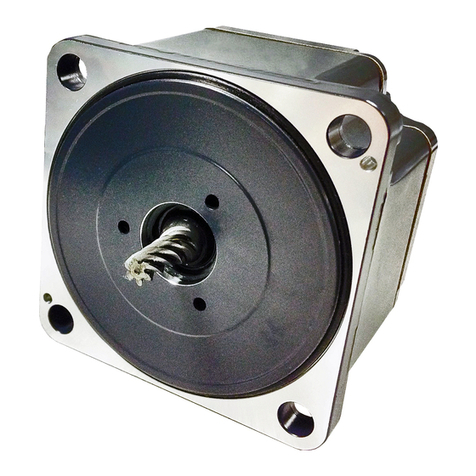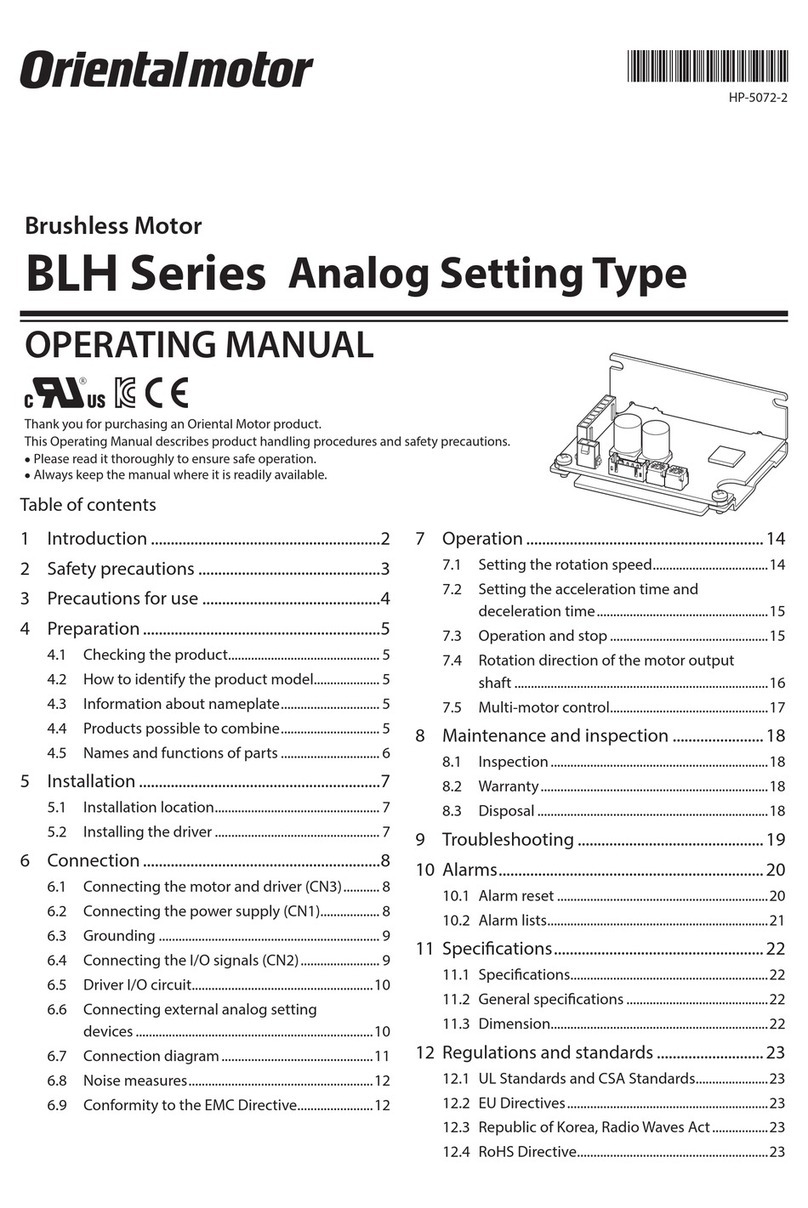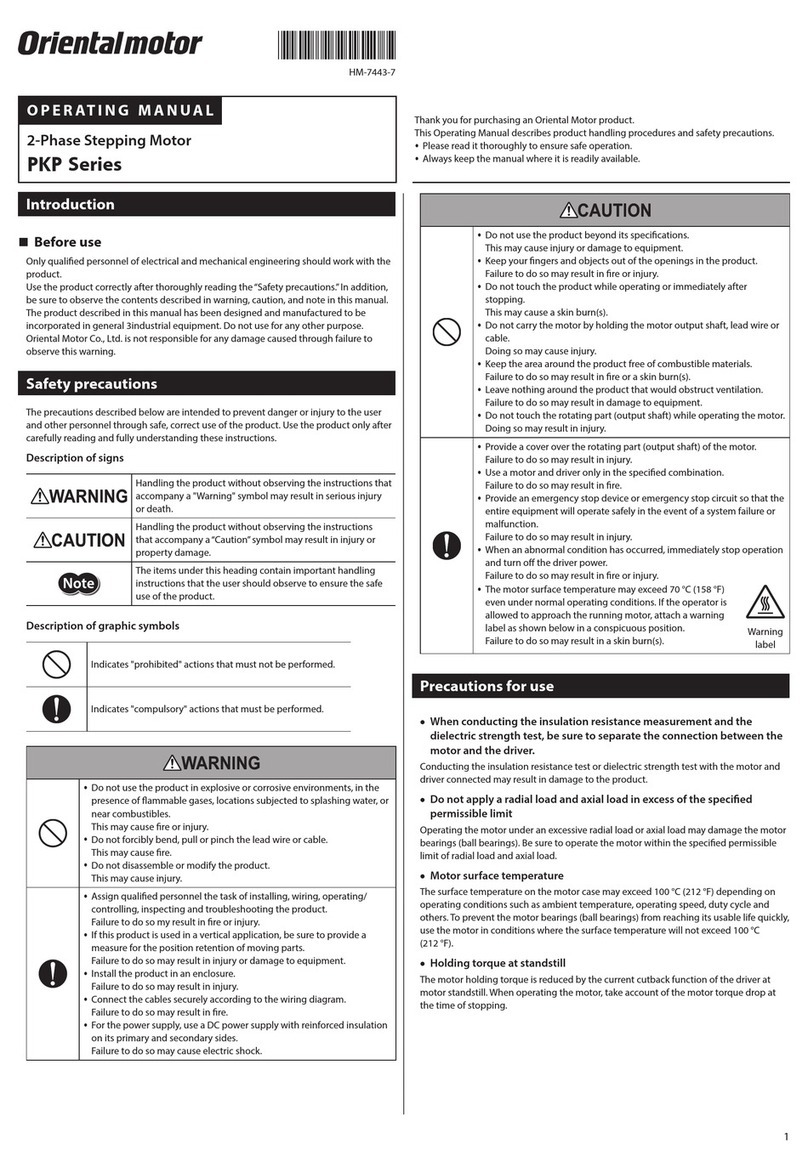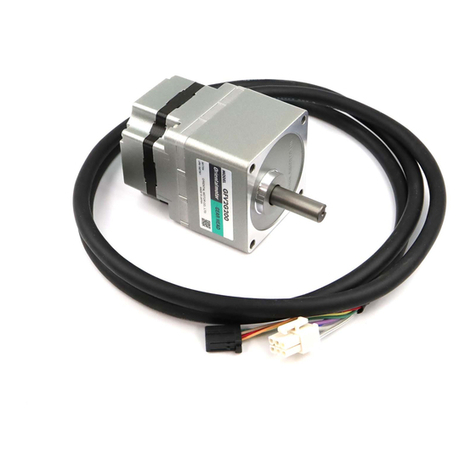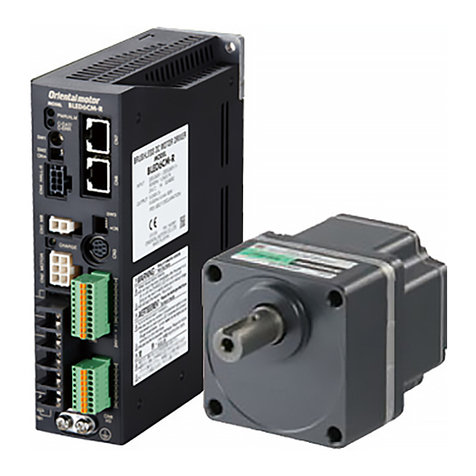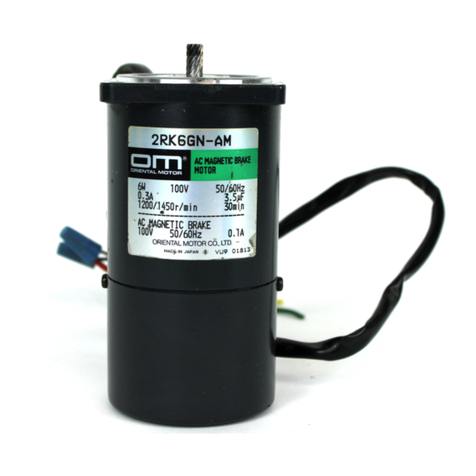
2
Installation
yTo prevent the risk of electric shock, use the motor for class I equipment only. (Not
required when the driver’s power supply specication is 24 VDC.)
yInstall the motor so as to avoid contact with hands, or ground them to prevent the risk
of electric shock.
Connection
yConnect the motor securely according to the motor connection method explained in
the USER MANUAL or OPERATING MANUAL (Driver). Failure to do so may result in re
or electric shock.
yDo not forcibly bend, pull or pinch the cables. Doing so may result in re or electric
shock.
Repair,•disassembly•and•modication
yDo not disassemble or modify the motor. This may cause electric shock or injury. Refer
all such internal inspections and repairs to the branch or sales oce from which you
purchased the product.
Handling the product without observing the instructions that accompany a “Caution”
symbol may result in injury or property damage.
General
yDo not use the motor beyond its specications, or electric shock, injury or damage to
equipment may result.
yDo not touch the motor during operation or immediately after stopping. The surface is
hot and may cause a skin burn(s).
Transportation
yDo not hold the motor output shaft or motor cable. This may cause injury.
Installation
yProvide a cover over the rotating parts (output shaft) of the motor to prevent injury.
yTo prevent the risk of damage to equipment, leave nothing around the motor that
would obstruct ventilation.
Operation
yDo not touch the rotating parts (output shaft) of the motor during operation. This may
cause injury.
yProvide an emergency stop device or emergency stop circuit external to the
equipment so that the entire equipment will operate safely in the event of a system
failure or malfunction. Failure to do so may result in injury.
yThe motor’s surface temperature may exceed 70 °C (158 °F),
even under normal operating conditions. If a motor is accessible
during operation, post a warning label shown in the gure in a
conspicuous position to prevent the risk of skin burn(s). Warning label
yFor the power supply input to the electromagnetic brake, use a DC power supply with
reinforced insulation on the primary side.
Maintenance•and•inspection
yTo prevent the risk of electric shock, do not touch the terminals while measuring the
insulation resistance or conducting a voltage-resistance test.
Disposal
yTo dispose of the motor, disassemble it into parts and components as much as
possible and dispose of individual parts/components as industrial waste.
Precautions for use
This section covers limitations and requirements the user should consider when using
the product.
•
•Always•use•the•cable•(supplied•or•accessory)•to•connect•the•motor•and•
driver.
Be sure to use the cable (supplied or accessory) to connect the motor and driver. In the
following condition, an appropriate accessory cable must be purchased separately.
yIf a exible cable is to be used.
yIf a cable of 3 m (9.8 ft.) or longer is to be used.
yIf a motor and driver package without a cable was purchased.
•
•Conduct•the•insulation•resistance•measurement•or•dielectric•strength•
test•separately•on•the•motor•and•the•driver
Conducting the insulation resistance measurement or dielectric strength test with the
motor and driver connected may result in damage to the product.
•
•Do•not•apply•a•radial•load•and•axial•load•in•excess•of•the•specied•
permissible•limit.
Operating the motor under an excessive radial load and axial load may damage the
motor bearings (ball bearings). Be sure to operate the motor within the specied
permissible limit of radial load and axial load. See page 4 for details.
•
•Use•the•motor•in•conditions•where•its•surface•temperature•will•not•
exceed•100•°C•(212•°F).
The driver has an overheat-protection function, but the motor has no such feature. The
motor case’s surface temperature may exceed 100 °C (212 °F) under certain conditions
(ambient temperature, operating speed, duty cycle, etc.). To prevent the motor bearings
(ball bearings) from reaching its usable life quickly, use the motor in conditions where its
surface temperature will not exceed 100 °C (212 °F).
Use the geared type motor in a condition where the gear case temperature does not
exceed 70 °C (158 °F), in order to prevent deterioration of grease and parts in the gear
case.
If the motor is to be operated continuously, install the motor in a location where heat
dissipation capacity equivalent to a level achieved with a heat sink [made of aluminum,
250×250×6 mm (9.84×9.84×0.24 in.)] is ensured.
•
•Double•shaft•motor
Do not apply load torque, radial load or axial load to the output shaft on the opposite
side of the motor output shaft.
•
•Holding•torque•at•standstill
The motor holding torque is reduced by the current cutback function of the driver at
motor standstill. When selecting a motor, check the holding torque at motor standstill in
the specications on the catalog.
•
•Do•not•use•the•electromagnetic•brake•to•reduce•speed•or•as•a•safety•
brake.
Do not use the electromagnetic brake as a means to decelerate and stop the motor. The
brake hub of the electromagnetic brake will wear signicantly and the braking force will
drop. The electromagnetic brake is of power-o activated type. This means that although
it helps maintain the position of the load in the event of power outage, etc., this brake
cannot securely hold the load in place. Accordingly, do not use the electromagnetic
brake as a safety brake. To use the electromagnetic brake to hold the load in place, do so
after the motor has stopped.
•
•Preventing•electrical•noise
See USER MANUAL for measures with regard to noise.
•
•Peak•torque•of•geared•type•motor
Always operate the geared type motor under a load not exceeding the peak torque. If
the load exceeds the peak torque, the gear will be damaged.
•
•About•grease•of•geared•motor
On rare occasions, a small amount of grease may ooze out from the geared motor. If
there is concern over possible environmental damage resulting from the leakage of
grease, check for grease stains during regular inspections. Alternatively, install an oil pan
or other device to prevent leakage from causing further damage. Oil leakage may lead to
problems in the customer’s equipment or products.
•
•Rotation•direction•of•the•gear•output•shaft
The relationship between the rotation direction of the motor shaft and that of the gear
output shaft changes as follows, depending on the gear type and gear ratio.
Type of gear Gear ratio Rotation direction (relative to the
motor rotation direction)
TH geared 3.6, 7.2, 10 Same direction
20, 30 Opposite direction
PL geared, PS geared
PN geared All gear ratios Same direction
Harmonic geared All gear ratios Opposite direction
•
•Do•not•perform•push-motion•operation•with•geared•types.
Doing so may cause damage to the motor or gear part.
Preparation
Checking the product
Verify that the items listed below are included. Report any missing or damaged items to
the branch or sales oce from which you purchased the product.
zWhen purchasing a motor and driver package
yMotor ........................................................................... 1 unit
yDriver............................................................................ 1 unit
yParallel key ................................................................. 1 pc. (Supplied with geared types) *1
yConnectors bag ........................................................ 1 pc
(refer to the table on the right for the packing items)
yVaristor ........................................................................ 1 pc.
(Supplied with electromagnetic brake motors combined with a driver of DC power
input Pulse input type)
yCable for motor ........................................................ 1 pc. *2
yCable for electromagnetic brake ....................... 1 pc. *2
(Supplied with electromagnetic brake type)
